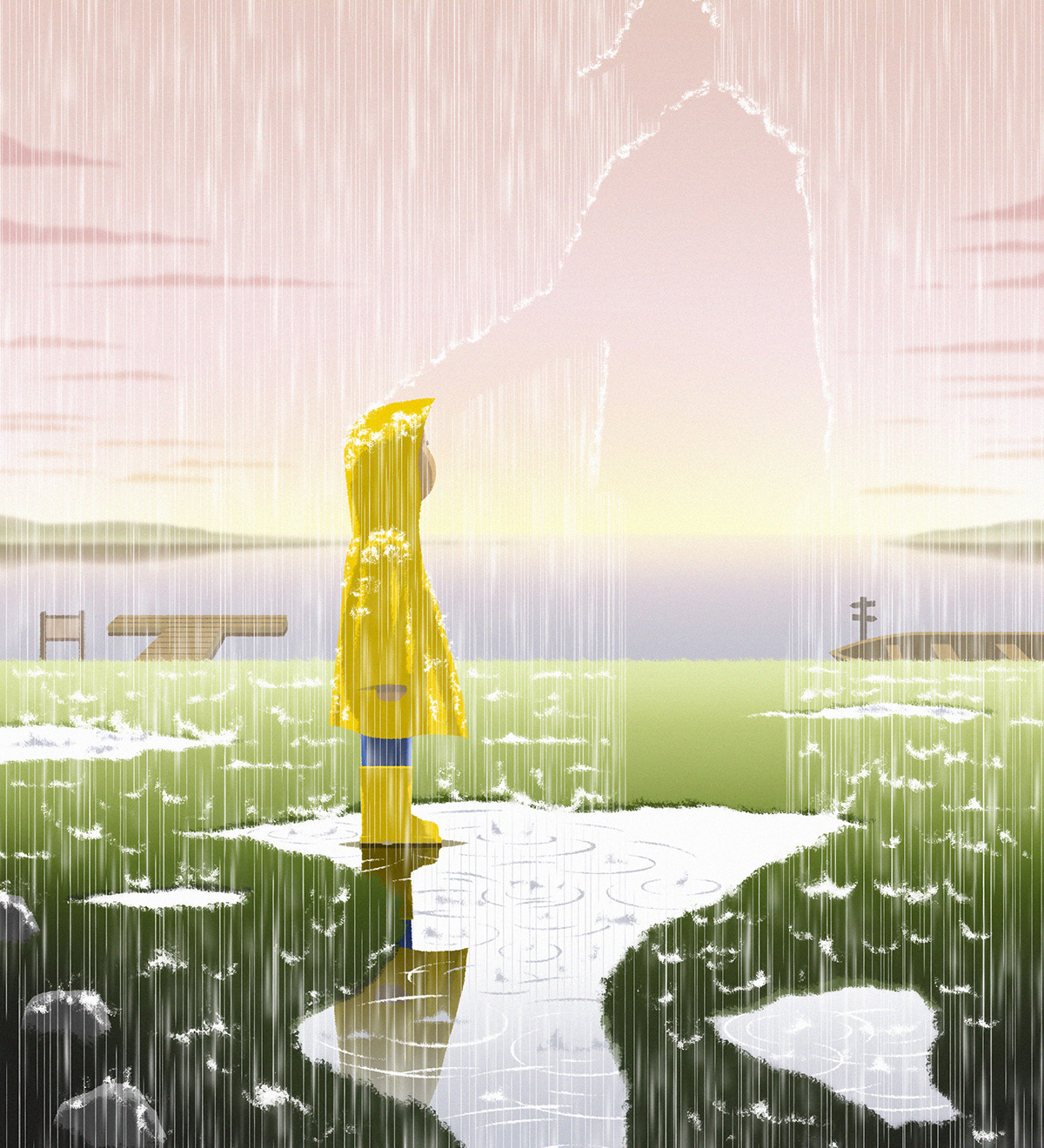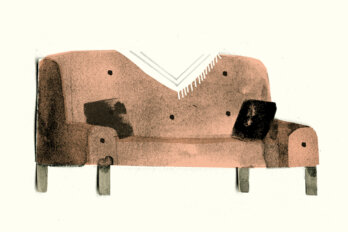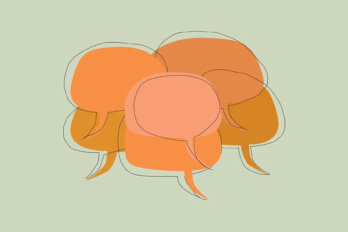Last June, four boys bonded inside a summer camp cabin.
After throwing loose shirts into cubbies and spreading sleeping bags onto sandy mattresses, a game of tag around the bunk beds quickly evolved into “the floor is lava.”
Concealed within the laughter, however, was a link these four boys, all between the ages of five and seven, didn’t yet know about: each of them had lost a father. And I, their camp counsellor for the weekend, had lost mine too.
But “lost” wasn’t the right word.
As my co-counsellors and I learned from our training a few weeks earlier, being specific with language was imperative at grief camp. It was better to avoid any euphemisms like “passed away” and “lost,” as they could inadvertently add confusion to the despair. In a child’s mind, when something is lost, it can also be found. Our fathers would not be found.
“Do you know why you’re all here?” asked a social worker, our group’s clinical lead, once the boys settled into silence. Afternoon sunlight rippled over the wooden floor we sat on.
“To have the best time ever!” the youngest replied. “And to play basketball!”
“Yes, that’s true,” the social worker said. “But there’s another reason you’re all here. . . . Every single kid at this camp, including some of your counsellors, has had someone really important to them die.”
The boys looked at one another, unsure of what to say next.
The ensuing days at this summer camp in McKellar, Ontario, a two-and-a-half-hour ride north of Toronto, would be full of traditional camper activities. More than a hundred boys and girls would climb the high ropes, jump into the lake for polar bear dips, and roast s’mores around campfires. But beneath the cheery surface of the conventional childhood experience, this was a different type of program. Here, a group of grieving kids—and the adults overseeing them—would try to find solace in the outdoors.
I first heard about Camp Erin a little more than a year after my father’s funeral. A friend whose dad had also died sent me a link to the program, telling me the organization was recruiting volunteers. It is the largest national bereavement program for youth grieving the death of a parent or sibling.
The program was created by the Eluna Network, an organization that provides resources for children affected by death, and is offered in every city that has a Major League Baseball team. This bit of trivia isn’t a coincidence: one of its founders, Jamie Moyer, is a former MLB pitcher.
The annual weekend was inspired by Erin Metcalf, a fifteen-year-old girl Moyer and his wife, Karen, first met in the late ’90s through the Make-a-Wish Foundation. Erin had lung cancer. When she was hospitalized, she repeatedly expressed her concern for other visiting children as well as her own siblings, saying that she wanted to ensure they received the necessary support as they, too, navigated this scary reality. When Erin died at the age of seventeen in 2002, the Moyers felt that creating a “grief camp” to fulfill Erin’s wishes would be a fitting tribute. And since then, hundreds of summer camps throughout North America have offered their facilities every year for the free weekend program.
As great as that all sounded, I felt hesitant about volunteering. I didn’t doubt the program’s merits; I grew up attending camp in northern Ontario, and it offered some of the most important experiences of my young life. But I couldn’t reconcile the mix of bereavement and summer camp. What would we do—sit around a campfire and cry into each other’s shoulders? As counsellors, would we spew platitudes about grief dissolving with time? Would there be moments of emotional vulnerability that I wouldn’t know how to respond to? Most of all, I wondered if I’d really be able to help any of those kids experiencing the death of a loved one so early in life.
My father died when I was twenty-five. I was young by most standards but old enough to see that I was privileged to grow up with him. The kids at the camp were dealing with something different. They were going through not only the loss of a loved one but the absence of opportunity. They were grieving not only what they had but what they will never be able to experience: a father or mother teaching them how to drive, or cheering at their high school graduation, or celebrating their first job.
Moreover, I knew there would also be children at the camp grieving the loss of a sibling, something I couldn’t relate to. What I would soon recognize, however, was that grief is not an exclusive club, and that everyone, no matter their experience, is invited to its miseries—as well as its joys.
Adults don’t tend to deal well with death. Yes, it’s in our shows, our songs, our art, our novels. But real deaths, the ones that take those we love, can feel taboo. We avoid talking about how loss feels, as though keeping the words out of our mouths will also keep the thoughts out of our minds. A 2019 survey conducted by online medical resource WebMD found that those experiencing grief often feel rushed to “get over it.” Nearly three-quarters of all respondents had grieved a death within the past three years, and a little more than half said they felt expected to “move on” soon after, often as early as three months following the loss.
Adults have spent years immersed in our culture’s troubled relationship with death. We may not like the various boundaries this relationship imposes, but we have been conditioned to accept them. For children, it’s different. Nicky Seligman, a child and adolescent grief counsellor and the clinical director of Camp Erin Toronto for the summer of 2022, said it comes down to how bereavement is conceptualized. “I think there’s so many misconceptions and myths in society and in the media,” she told me over the phone. Our depictions tend to be rigid and simplistic: when referring to the way grief is often portrayed on screen, with characters in all-black clothing, or a grieving lover falling to their knees before a rain-soaked grave, Seligman used the term “one dimensional.” That version of grief is something that a character trudges through until they arrive at the other side, a challenge to overcome.
“When you’re working with kids, a lot of it is about debunking some of those myths and helping them really understand that dynamic experience of grief and all of the different feelings and behaviours and experiences they may have,” Seligman said.
Grief is non-linear. One day, three years after a death, grief can return and feel as extreme as it did in the immediate aftermath of the loss. The ultimate difference between child grief and adult grief, she said, is how children will re-grieve throughout their lives.
For a young child experiencing the death of a parent, “their cognitive abilities are going to grow and change,” Seligman said. At first, the finality of death might not register as clearly, but their understanding of that finality will mature with age; the implications of a loved one’s physical absence will become more pronounced as they grow older.
“Part of that process is meeting kids where they’re at,” she said. “And helping them explore those questions and meet their developmental needs.”
I faced something similar in my first moments at Camp Erin, when we sat in that circle in the cabin after the kids were told, for the first time, that most of the camp was grieving the death of someone special.
“You too?” the youngest asked, his big eyes peering my way.
“Yeah. Me too.”
“Who?”
“My dad.”
His little face formed an expression of empathy that seemed beyond his years. “How did he die?”
“Cancer,” I said.
“What’s cancer?” asked another camper.
“It’s a disease where your body shuts down from bad cells that spread,” I said. “It was really hard and scary.”
Another part of our training—which took the form of online and in-person classes—was to lean into open dialogue like this and express vulnerabilities too often bottled up. This, we were told, would make children feel less alone in their own confusion.
Andrea Warnick is a registered psychotherapist, nurse, and thanatologist (or death researcher) who facilitated Camp Erin Toronto’s training. She explained that transparency and inclusion are proven to lessen a child’s sense of isolation while grieving. “It’s not a child’s job to open these conversations,” she said. “That’s an adult responsibility—to start the dialogue, to teach kids that we can talk about these really hard things.”
When adults avoid engaging in these conversations with children, “we’re making something that is already a really difficult and heartbreaking experience that much harder,” she said. “We’re losing the opportunity to clarify for them that, yeah, this really sucks, [and that] this is really hard for the adults too.
It doesn’t look like the adults are having a hard time, but it is hard. And it’s natural that you’re feeling what you’re feeling. There’s nothing you could have done to stop this.”
“The north wind blows if you love chocolate ice cream!” shouted Ken, the program director, a bearded, high-energy guy campers naturally gravitated toward. He was standing with a megaphone at the centre of a field, surrounded by more than a hundred kids and volunteers.
The moment he called out, all the chocolate ice cream lovers launched off, running across the field to find another spot in the circle.
“The north wind blows” is a simple icebreaker. Personally, I prefer vanilla, but my campers grabbed my arms and yanked me for the sprint. One camper jumped on for a piggyback as we cannoned across the field.
“The north wind blows if . . . you can’t wait to do the polar bear dip tomorrow morning!” Ken yelled.
I would find out later that none of my four campers actually knew what a polar bear dip was. Even so, they once again pulled me along. Spring sunshine beamed down on us, and the branches of surrounding trees swayed in the light breeze.
At first, Ken carried on with gentle prompts along these lines. But, slowly, things began turning serious.
“The north wind blows if . . . ” He paused for a second or two longer, and his voice softened. “You miss someone you love.”
Every camper, this time, and many staff changed spots in the circle. Ken started getting more specific.
“The north wind blows if . . . your mother died.”
Kids looked around. A silence settled. At a slower pace this time, a group of boys and girls, scattered throughout the field, shuffled to new spots. As did a cluster of adults.
The campers exchanged glances, noticing all the other kids who had shared a similar experience. Before this weekend, many of them had probably never met another person their own age whose mom had died.
“The north wind blows if . . . your father died.”
I crouched down next to my boys, who were staying close, as if afraid of the sudden change of tone. “That’s all of us,” I said gently.
Two of them grabbed my hands, one of them grabbed an arm, and another hung on for the piggyback.
Together, we moved to another spot in the circle.
“The north wind blows if . . . having someone you love die was really scary and sad, and sometimes you feel alone and confused.”
I crouched down again. The boys now seemed closer to me, like they would follow me anywhere. Our eyes said what words couldn’t. Once again, we all moved to another spot.
“The north wind blows if . . . even though you miss that person, and you’re sad, you could still be happy and have fun!”
“Hmmm . . . I’m not sure, guys,” I said, bending low. “I think we need to be sad all the time, right?”
Hoisting two kids onto my shoulders, I shouted, “Wrong!” We burst across the field, a whir of giggles in our wake.
When talking about how kids experience grief, Warnick described it as a puddle: something easy to jump in and out of. For adults, grief can feel more like an ocean, its vastness debilitating.
Children, Warnick explained, can abruptly transition from feeling devastated one moment to joyful the next. This is a healthy and normal approach to the messiness of grief, which doesn’t abide by a “neat and tidy” narrative. Happiness doesn’t disqualify grief, she said. “Happiness is part of grief.”
Adults, meanwhile, are less able to transition from one emotion to the next. “I think a common myth in grieving adults—and I see this in [older] teens a fair bit too—is this ‘black hole phenomenon,’” Warnick said. This is where grievers believe that if they feel the full intensity of their bereavement, they are going to get swallowed whole and remain stuck. The irony is that this fear of getting stuck becomes the real trap.
In denying despair, “there’s an entire blunting out of feeling that happens,” she said. People may not feel the grief, for instance, but they also won’t feel the joy or the gratitude. Warnick said the only way to experience one end of the emotional spectrum—the positive feelings that grief does not disqualify—is by “opening it all up.”
I could relate. After my father died, I remember armouring my mind against the pain. The result was a head-to-toe numbness that prevented me from feeling anything at all. The numbness dissolved only days after my dad’s funeral, when I let out an unrestrained cry. It happened on a hike, surrounded by trees. Somehow, the spring leaves and open air seemed to offer permission to unblock the emotions I had lost access to. I sat down and leaned against an old cedar. The sensation was physical at first—a loosening of my shoulders, an expansion in my tight chest. This bodily unravelling cleared the way for the mental turmoil I had pushed aside. It leaked out; then it cascaded. I wept and yelled. When it was over, I smiled. A lightness carried me through the following days.
Surrender such as this, Warnick said, is key. It’s the ultimate difference between how adults and children process death. “Many kids, especially the younger they are, [are] just going to allow themselves to [experience it.] And it’s going to happen,” she said.
This can look a million different ways: withdrawal, exhaustion, anger, fixation, depression, and distraction are all behaviours that grief counsellors like Warnick identify in kids. But these periods of negative reaction are often less prolonged than they would be for grown-ups.
Warnick believes this comes from an inherent understanding that kids grasp quicker: that emotional pain is “not going to stay.” Recognizing this allows grievers to feel their pain and move through it. “I think that that’s a huge [lesson] for adults from kids—that, actually, there’s real utility in allowing yourself sometimes to even be brought to your knees.”
After lunch one day at Camp Erin, sitting in the cabin, the social worker prompted us to reveal photos of our fathers, which most of the boys’ mothers had packed.
What followed was a sort of show-and-tell session, featuring fathers who had died of various causes, from tragic accidents to illness. I showed a picture of my dad, smiling as he sat on a swing set, wearing a blue button-up, his legs pointed toward the sky.
Eventually, my co-counsellor, Julia, showed a photo of a young man in a yellow shirt. He looked about my age. “This is my son, Clayton,” she told us.
Julia was a mother of three boys—two of whom I actually knew, because, coincidentally, we went to the same summer camp growing up. Her oldest, Clayton, died of an accidental drug overdose in September 2017. He was nine days away from his twenty-third birthday.
“This was an extremely devastating and traumatic and unbelievably sad thing for me, my husband, and my two other sons,” she told me later.
Julia first volunteered at Camp Erin Toronto in June 2019, after learning about the program through her involvement in a group for moms who had had a child die. Her first experience at Camp Erin, she told me, was therapeutic and allowed her to experience her bereavement fully. She was caught off guard by how the kids around her could switch from despair to joy, effortlessly moving from making emotional confessions to giggling in canoes. Julia said helping those children opened her eyes to how she could reclaim parts of her own life. “You’re so in your head about your own grief and then you see these kids and you want to a) help them and b) you see how they just turn on and off,” she said.
Julia had been on leave from her job for nearly two years before she went to Camp Erin. After that first weekend, she felt ready to go back to work. In June 2022, after a pandemic-enforced hiatus, she returned to camp as a counsellor for a second time.
Julia and I became fast friends. We were a team, stopping our four troublemakers from their inclinations to jump off high structures, tip canoes, and, once, eat bowls of white sugar for breakfast. Her instincts for ensuring the kids always had enough sunscreen, hydration, and nutrition at the dinner table (the last one being no easy thing to guarantee at buffet-style meals), along with her boundless patience, intimately reminded me what she was: a veteran mother of three boys.
Julia noted the quick bond the little guys felt toward me. “They heavily related to you,” she reflected during our phone call. She told me that, over that weekend away, I was able to fill in as a male figure for our group, a facilitator of mischief and horseplay. “The fact that you were there and you had lost a father too—that was something that helped them connect really quickly.”
As healing as the experience was, however, Julia also noted a disconnect between the kids and her experience with grief. “I remember telling them that my son died, and I think it was something they almost couldn’t understand,” she said.
What they did understand, however, was that they had permission to feel however they chose to and to lean into the excitement and fun. Our boys rolled down grassy hills. They drummed the table in the mess hall. They found and named three caterpillars (Gerry, Larry, and Harry). They danced on stage for the camp talent show. They raced from one activity to the next. It was all exhausting. But it was also energizing.
Julia recalled a specific moment, after we paddled canoes, when the youngest boy turned to her and said, to her astonishment, “This is the best day of my life.”
Recalling this comment, Julia emphasized the absurdity. “He’s at a grieving camp!”
The lake shimmered with an orange glow as the whole camp sat before a fire pit and an evening wind rolled in, carrying the forest’s aroma of cedar and oak. In place of a fire, however, we all had our attention on a large blue board. Painted on a white piece of fabric strung to the top were the words “In Memory Of . . . ”
As Ken softly strummed an acoustic guitar, cabin groups were called for what was known as the “photo ceremony.” One at a time, children of all ages revealed a photo of the person they were grieving. They declared, sometimes in quaking voices, how the person had died, before clipping the image to the board.
“This is my dad. He died of suicide.”
“This is my brother. He died of a drug overdose.”
“This is my mother. She died of cancer.”
Soon enough, every inch of the board was plastered with smiling faces.
At this moment, none of my own grief was pointing inward. There was a feeling of expansiveness that emanated as my campers sat close to me, all of us watching the scene unfold.
Julia, sitting to my left, threw an arm around my shoulder, and the simple—maybe even clichéd—lesson of the weekend suddenly became pronounced: togetherness makes sorrow a little easier to bear.
When our cabin was called, our four boys stood up and spoke bravely about their fathers. After them, I shared the image of my dad on the swing. Then I bent down and clipped it to the board.
Seeing him there, amid all the mothers and fathers, brothers and sisters, sons and daughters, I reminded myself he wasn’t lost. And neither were we.





